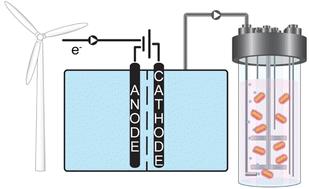当前位置:
X-MOL 学术
›
Energy Environ. Sci.
›
论文详情
Our official English website, www.x-mol.net, welcomes your feedback! (Note: you will need to create a separate account there.)
Electrical-energy storage into chemical-energy carriers by combining or integrating electrochemistry and biology
Energy & Environmental Science ( IF 32.5 ) Pub Date : 2024-03-27 , DOI: 10.1039/d3ee01091k Largus T. Angenent 1, 2, 3, 4, 5 , Isabella Casini 1 , Uwe Schröder 6 , Falk Harnisch 7 , Bastian Molitor 1, 5
Energy & Environmental Science ( IF 32.5 ) Pub Date : 2024-03-27 , DOI: 10.1039/d3ee01091k Largus T. Angenent 1, 2, 3, 4, 5 , Isabella Casini 1 , Uwe Schröder 6 , Falk Harnisch 7 , Bastian Molitor 1, 5
Affiliation

|
Our societies must reconsider current industrial practices and find carbon-neutral alternatives to avoid the detrimental environmental effects that come with the release of greenhouse gases from fossil-energy carriers. Using renewable sources, such as solar and wind, allows us to circumvent the burning of fossil energy carriers to produce electrical energy. However, this leads to a spatial-temporal discrepancy between production and demand, necessitating the ability to store vast amounts of electrical energy. Physical storage of electrical energy, such as hydropower and underground pressure storage, as well as the conversion of electrical energy into chemical energy, such as with batteries, can offer vast storage capacities. Another route of storing electrical energy at a massive scale is its conversion into chemical-energy carriers by combining or integrating electrochemistry with biology. Here, we will give an overview of the potential of these biological-storage technologies. Based on the order in which they combine or integrate biological and electrochemical steps, we will discuss the current state of research on these technologies in three distinct sections: (1) electrochemistry followed by biology; (2) biology followed by electrochemistry; and (3) integrated electrochemistry and biology. We will discuss research needs and opportunities in an outlook section at the end.
中文翻译:

通过结合或整合电化学和生物学将电能存储为化学能量载体
我们的社会必须重新考虑当前的工业实践,并找到碳中和的替代方案,以避免化石能源载体释放温室气体所带来的有害环境影响。使用太阳能和风能等可再生能源,使我们能够避免燃烧化石能源载体来生产电能。然而,这导致生产和需求之间的时空差异,需要存储大量电能的能力。电能的物理存储(例如水力发电和地下压力存储)以及将电能转化为化学能(例如电池)可以提供巨大的存储容量。大规模存储电能的另一种途径是通过将电化学与生物学相结合或整合,将其转化为化学能载体。在这里,我们将概述这些生物存储技术的潜力。根据生物和电化学步骤结合或整合的顺序,我们将分三个不同的部分讨论这些技术的研究现状:(1)电化学,然后是生物学; (2)生物学,其次是电化学; (3)综合电化学和生物学。我们将在最后的展望部分讨论研究需求和机会。
更新日期:2024-03-27
中文翻译:

通过结合或整合电化学和生物学将电能存储为化学能量载体
我们的社会必须重新考虑当前的工业实践,并找到碳中和的替代方案,以避免化石能源载体释放温室气体所带来的有害环境影响。使用太阳能和风能等可再生能源,使我们能够避免燃烧化石能源载体来生产电能。然而,这导致生产和需求之间的时空差异,需要存储大量电能的能力。电能的物理存储(例如水力发电和地下压力存储)以及将电能转化为化学能(例如电池)可以提供巨大的存储容量。大规模存储电能的另一种途径是通过将电化学与生物学相结合或整合,将其转化为化学能载体。在这里,我们将概述这些生物存储技术的潜力。根据生物和电化学步骤结合或整合的顺序,我们将分三个不同的部分讨论这些技术的研究现状:(1)电化学,然后是生物学; (2)生物学,其次是电化学; (3)综合电化学和生物学。我们将在最后的展望部分讨论研究需求和机会。



























 京公网安备 11010802027423号
京公网安备 11010802027423号